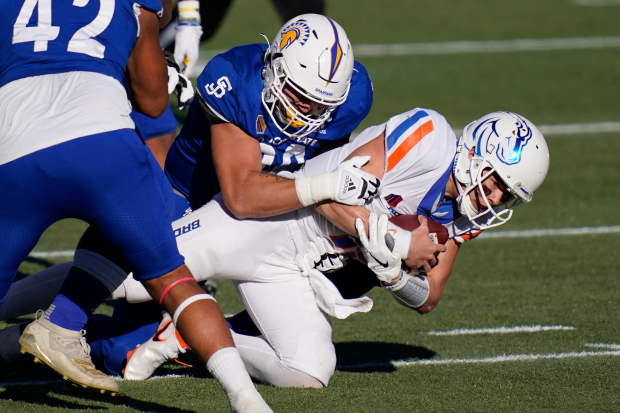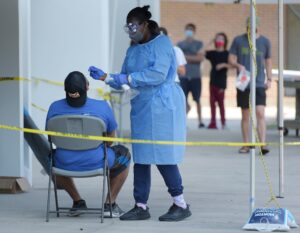San Jose State has marched through lakes of fire to get here.
For the moment, don’t tell the Spartans that the real heat dome is coming.
They represent the cannon fodder of the Football Bowl Subdivision. They play for the one-star recruits, the coaches who share cubicles, the programs that don’t have putt-putt golf courses in their football buildings, the ones that don’t have football buildings at all.
They love the game, practically by process of elimination. Why else would they play it?
“It’s hard to keep showing up when you keep losing games,” said Cade Hall, the 2020 Mountain West Conference Defensive Player of the Year.
San Jose State won the conference last year with a 7-0 regular-season record, although it lost its bowl game to Ball State when Hall and five other starters were out. Only two years ago, the Spartans were 1-11.
A program that practically had to give out coupons to lure fans now had games worth watching and did it in a year when no one could watch at all.
This year’s Spartans return all 11 defensive starters, plus quarterback Nick Starkel. They open their season against Southern Utah on Aug. 28 before meeting USC on Sept. 4 at the Coliseum. A close game, defined by USC fans as one decided by fewer than 40 points, is a possibility, and if it happens, the CDC will be giving free rabies vaccinations on the Coliseum concourse.
In any event, the Spartans will keep putting one foot ahead of the other in the race against reality.
Conference consolidation, with Texas and Oklahoma joining the SEC, will make for glitzier TV matchups and another reason not to watch the home team. The rewards for Name, Image and Likeness might actually help players in a one-team market like San Jose, but the wide-open transfer portal could lure precocious Spartans into trying the “big time.”
In 2004 the faculty voted to drop football. In response, the school reduced the percentage of university funds going to athletes from 3.2 percent to 2.
Who’s to argue? The Spartans drew an average of 12,184 fans in 2019 and have not had a home crowd of 20,000 since 2011 (against Navy). They have not had back-to-back winning seasons since a four-year streak that ended in 1992.
Brent Brennan, an Oregon State assistant and UCLA alumnus, looked like the next sacrificial coach when hired in 2017. He went 8-29 in his first three seasons but got a contract extension. Then came 2020.
“Those early years, we had to be positive,” said Derrick Odum, the defensive coordinator who came with Brennan. “As the games went on we kept making more good plays, so we had to point those out. We were down 28-0 to Colorado State and came back to lead 30-28 and then we lost, but we could show them what they were capable of. We played Army and were close at halftime and then turned it over five consecutive times to start the second half (and lost, 52-3). We weren’t going to beat them up over it.”
Because the top tier of high school players is identified so quickly and recruited so busily, there are a lot of Cade Halls underneath.
Hall was a dominant high school player at Bellarmine Prep in the San Jose suburbs, and his dad Rhett played at Cal and then for eight years with the San Francisco 49ers. Since there’s no easy checklist for brains and desire, Hall wasn’t recruited by Pac-12 programs.
“The coaches sold the fact that they were changing everything,” Hall said. “Even though we were losing so much, we knew we were on the right track.”
Hall’s video breakdowns of opposing blockers and his adherence to the nutrition programs built him into a force. Now at 6-foot-3 and 270 pounds, Hall has started 27 games and had 10 sacks last season.
The beacon of those building years was a 31-24 win at Arkansas in 2019, when the Spartans finished 5-7. Starkel was the Razorbacks’ quarterback that day. He was at Texas A&M before that. He’s entering his sixth collegiate season, and last year he threw for 16 touchdowns with four interceptions in the regular season.
Odum, meanwhile, tries to keep it interesting for his veteran defenders.
“A lot of things are second nature now,” he said. “We’ll have some new wrinkles, but when you see Nolan Ryan throw a fastball, you don’t try to change it. You see all the guys communicating on a high level before the ball is snapped. It’s a beautiful thing. That’s what you want.
“These guys have grown up together. The last thing we want is to be a flash-in-the-pan program.”
That’s why 2021 is so urgent. Out there somewhere, there’s a frying pan awaiting.






















